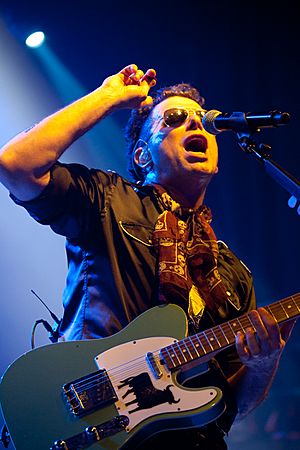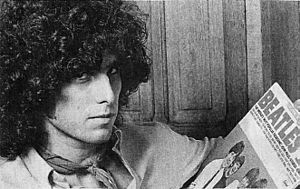Andrés Calamaro facts for kids
Quick facts for kids
Andrés Calamaro
|
|
|---|---|

Calamaro performing in 2010
|
|
| Background information | |
| Birth name | Andres Calamaro |
| Born | August 22, 1961 Buenos Aires, Argentina |
| Genres | |
| Occupation(s) | |
| Instruments | |
| Associated acts |
|
Andrés Calamaro, born on August 22, 1961, is a famous musician and composer from Argentina. He has won a Latin Grammy award. Many people think he is one of the most important and influential rock artists who sings in Spanish. He is also known for being very versatile, playing many different musical styles. These styles include funk, reggae, ballads, boleros, tangos, and jazz.
His former band, Los Rodríguez, was very successful in Spain and across Latin America during the 1990s. Andrés Calamaro can play many instruments, making him a multi-instrumentalist. He has become one of the biggest names in Argentine rock, selling over 1.3 million records.
Contents
Life and Music Journey
Starting with Los Abuelos de la Nada
Andrés Calamaro was born in Buenos Aires, Argentina. When he was 17, he played as a guest on an album by the group Raíces. Soon after, he started his own band called Elmer Band with his friend, guitarist Gringui Herrera. This band had a popular underground song called Tristeza de la Ciudad (City Blues).
Later, Miguel Abuelo, the leader of Los Abuelos de la Nada, returned to Argentina. He reformed his band and invited Calamaro to play keyboards. This band became very successful. Calamaro wrote some of their biggest hits, like Sin gamulán, Mil horas, and Costumbres argentinas.
Andrés Calamaro's First Solo Music
Before Los Abuelos de la Nada broke up, Calamaro released his first solo album, Hotel Calamaro, in 1984. His second album, Vida Cruel, was recorded soon after he left the band. Critics liked it, but it did not sell many copies.
After his third album, Por Mirarte (1988), Calamaro started working as a producer for other bands. He helped groups like Los Fabulosos Cadillacs and Los Enanitos Verdes. He also produced music for solo artists like Fabiana Cantilo. Calamaro ended the 1980s with his own band. It included his old friends Gringui Herrera and Ariel Rot, who had just returned from Spain. In 1989, the trio recorded the album Nadie sale vivo de aquí (No One Gets Out of Here Alive). Many guest musicians also played on this album, which was nominated for Best Record of the Year.
In 1990, Calamaro helped produce the album Mujer contra mujer. This album was by Sandra Mihanovich and Celeste Carballo.
Success with Los Rodríguez
Because of the economic situation in Argentina, Calamaro and Rot moved to Spain. There, they formed the band Los Rodríguez with Julián Infante and Germán Villela on drums. The band did not have a permanent bass player. However, Guillermo Martin, Candi Avello, and later Daniel Zamora played bass for their recordings and tours.
Los Rodríguez released three very successful studio albums. These were Buena Suerte (1991), Sin documentos (1993), and Palabras más, palabras menos (1995). They also released a live album, Disco Pirata (1992), and a collection of songs, Hasta luego (1996). The album Sin documentos brought them international fame. It mixed Rock, Flamenco, and Latin American rhythms. They toured extensively in Spain and Latin America. Their music became a big part of the history of Rock in Spanish.
Andrés Calamaro's Solo Career Continues
Andrés Calamaro released Grabaciones Encontradas ("Found Recordings") while he was still with Los Rodríguez. After Palabras más, palabras menos, the band released a "Greatest Hits" album that sold very well. Then, the band decided to break up.
In 1996, Calamaro performed "Cosas Que Me Ayudan A Olvidar" (Things That Help Me To Forget). This song was for the AIDS benefit album Silencio=Muerte: Red Hot + Latin. The Red Hot Organization produced this album. In 1997, Calamaro recorded Alta suciedad. This title is a play on words, meaning "High Filth" but sounding like "High Society." The album sold over half a million copies. This success led him to tour Latin America again.
Calamaro then started writing many songs very quickly. In just six months, he had over 100 songs ready. Thirty-seven of these songs were included in his next album, Honestidad brutal. This album featured popular songs like Te quiero igual, Paloma, Los aviones, Cuando te conocí, and La parte de adelante. This double CD was created during a difficult time in his life, which was reflected in the songs. The album also included a collaboration with the famous football player Diego Maradona.
In 2000, he recorded 103 songs for his five-CD album, El Salmón.
Sharing Music Freely
In the years that followed, Calamaro made many guest appearances in concerts and recordings. He also shared unreleased songs from 2001-2002 for free download online. He believed that "Music belongs to those who want to hear it; and to nobody else."
He also made his home recordings available online. Because some of these recordings were not high quality, a group of fans called Camisetas Para Todos re-mastered them. They made the improved versions available on their website with Calamaro's permission. He also started Radio Salmón Vaticano, which was like a virtual recording studio on his website.
In 2004, he released El Cantante (The Singer). This album featured covers of Tangos and other Latin American rhythms. It also included a few of the songs he had released online.
The Return to Live Performances
In 2005, Calamaro released El Regreso (The Return). This album was a collection of live recordings from his concert at the Luna Park Stadium earlier that year. He presented the album on December 17 to a crowd of 20,000 people at the Obras Sanitarias Stadium. The album won the 2006 Gardel Award for Rock album by Male Artist and Best Album Cover. Calamaro also received the Golden Gardel, which is the main award.
After that, he released Tinta Roja, a collection of classic Tangos. These included famous songs like El día que me quieras, Como dos extraños, and Sur. On November 20, 2006, El Palacio de las Flores was released. He recorded this album with Litto Nebbia. On September 11, 2007, La Lengua Popular came out. In 2008, he released Raíces 30 Años with the band Raíces. In 2009, he released Andrés, a solo collection of 6 CDs.
In June 2010, he released his album "On The Rock." This album brought back his more rock-oriented sound. It quickly became a hit, along with its first single "Los Divinos," a song about how time passes.
Discography
Los Abuelos de la Nada Albums
- Los Abuelos de la Nada (1982)
- Vasos y Besos (1983)
- Himno de mi Corazón (1984)
- En Directo desde el Ópera (Live Album) (1985)
Los Rodríguez Albums
- Buena Suerte (1991)
- Disco Pirata (1992)
- Sin Documentos (1993)
- Palabras más, Palabras menos (1995)
- Hasta Luego (1997)
- Hasta Luego (Collector CD/book) (2001)
- Para no olvidar (2001)
Andrés Calamaro Solo Albums
- Hotel Calamaro (1984)
- Vida Cruel (1985)
- Por Mirarte (1988)
- Nadie sale vivo de aquí (1989)
- Grabaciones Encontradas Vol. I (1993)
- Loco por Tí - Live in Ayacucho '88 (1994)
- Caballos Salvajes (1995)
- Grabaciones Encontradas Vol. II (1996)
- Alta Suciedad (1997)
- Las otras caras de Alta Suciedad (1998)
- Una Década Perdida (1998)
- Honestidad Brutal (1999)
- Alta Suciedad (Collector Series) (1999)
- El Salmón (2000)
- Duetos (2001)
- El Cantante (2004)
- El Regreso (2005)
- Tinta Roja (2006)
- Made in Argentina (DVD) (2006)
- El Palacio de las Flores (2006)
- La Lengua Popular (2007)
- Dos son Multitud (collaboration with Fito & Fitipaldis) (2008)
- Nada se Pierde (released by EFE EME magazine, with previous unpublished songs) (2009)
- On the Rock (2010)
- Bohemio (2013)
- Hijos del Pueblo (collaboration with Enrique Bunbury) (2015)
- Volumen 11 (2016)
- Cargar la Suerte (2018)
- Dios los Cría (2021)
See also
 In Spanish: Andrés Calamaro para niños
In Spanish: Andrés Calamaro para niños


